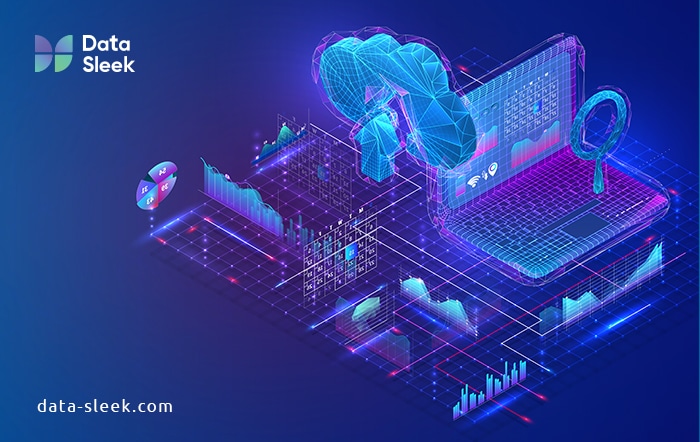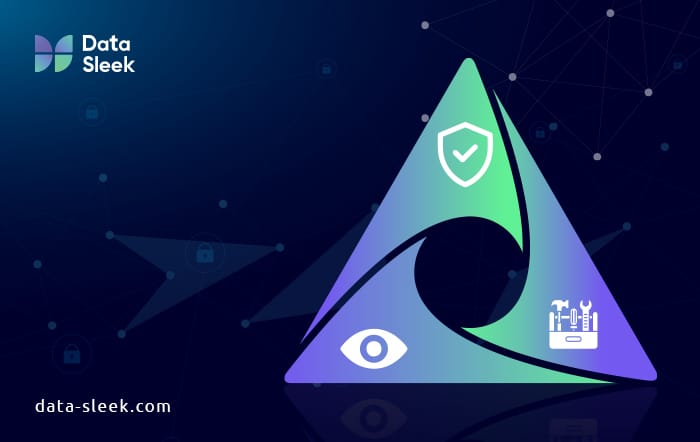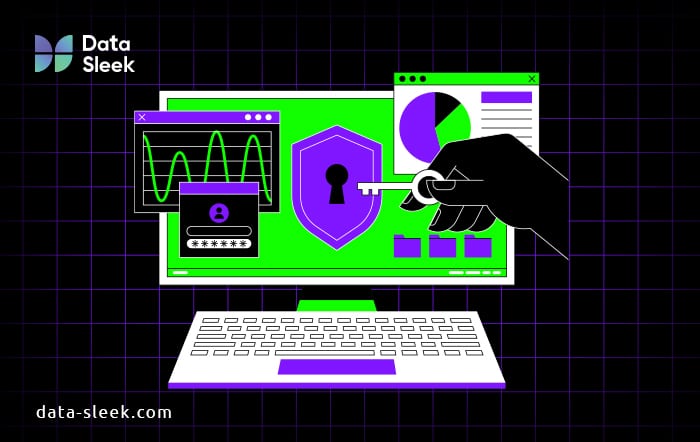Data is one of your business’s most valuable assets. Given the increasing sophistication of cyber threats, it must be protected through proactive and strategic measures. Data risk refers to the issues a company faces in protecting its data, encompassing a broad range of risks, including human error, cyberattacks, privacy violations, and data breaches. With the free downloadable assessment checklist at your disposal, your company will enjoy several benefits, including:
- Data security management best practices.
- Some of the best Data protection tools.
- Proactive cybersecurity practices to adopt and set benchmarks.
- Poor information security can result in severe reputational damage and financial losses.
What Is Data Risk Mitigation?
Data risk mitigation
Data risk mitigation focuses on mitigating the negative impact of data breaches that evade existing defensive measures, in contrast to prevention, which eliminates information security incidents before they occur, or detection, which provides awareness of active threats, In essence, prevention stops risks upfront, detection identifies active incidents, and mitigation focuses on handling any incidents that are already underway. Still, all three are part of data risk management. Practical data protection requires a balanced approach that incorporates all three elements.
Why Data Risk Mitigation Matters for Modern Organizations
Common Threats to Data
Data breaches:
The FCC defines data breaches as including “any access to, use, or disclosure of ‘covered data’ that is not authorized or that exceeds authorization. The Order states that this definition covers not only malicious activity, but also inadvertent unauthorized access to, use, or disclosure of covered data.” This definition is crucial when dealing with compliance risks as well as overall governance, risk, and compliance (GRC).

Ransomware attacks:
A devious strategy whereby cyber-criminals either pose as legitimate entities or otherwise gain access to a victim’s data, locking them out until the victim or victims pay a ransom. Unfortunately, such attacks often leave malware lurking in their wake, so even if the ransom is paid, the system should be considered compromised and kept isolated until proven otherwise.
Insider threats:
Several notable companies have had to deal with disgruntled employees who have had sufficient administrative access to corporate data and exploited this access to cause significant harm. Some gangs of cyber-criminals even go so far as to enter companies with malicious intent to fleece them for everything they can. Since data privacy controls are increasingly crucial to the average consumer, implementing strict standards is vital.
Third-party vulnerabilities:
Even if your cybersecurity strategy is on point, reactive, and robust, your company cannot control any vulnerabilities that exist within commonly used third-party software platforms. Regardless of fault, your company may be held liable for any data breaches that occur when using a particular product.
Data Risk Assessment: The First Step in Mitigation
What Is a Data Risk Assessment?
Enterprises face the challenge of protecting an ever-growing amount of data, which is accessed from various locations through the cloud. Maintaining visibility and control over both structured data, such as Personally Identifiable Information (PII), and unstructured data, including intellectual property, is both complex and necessary. A Data Risk Assessment (DRA) provides visibility into both structured (e.g., PII) and unstructured data (e.g., IP), highlights vulnerabilities, and recommends controls for compliance and resilience. It involves discovering known and unknown data across cloud and on-premises storage, classifying that data by criticality and regulatory needs, and offering steps to address identified risks, including asset risk evaluation.

The DRA process ends with the creation of a comprehensive report that includes recommendations for mitigating security and privacy issues, establishing proper data classification standards, and outlining practices for future prevention. Any organization concerned about data security strategy should undertake a DRA to ensure its compliance with any relevant regulations.
What Causes Data Risks?
Data risks can be caused by several potential problems that organizations need to address to minimize data threats:
- Ineffective management practices leads to data issues, including data misplacement, data loss, or unauthorized access to sensitive data.
- Human error has a significant impact on data risks. Employee mistakes include configuration issues with databases, errors in data entry, or accidental file deletions that often compromise data integrity and security.
- Data silos often exacerbate existing issues. Having isolated data within different departments or systems limits visibility and control, thereby hindering effective risk monitoring.
- Technology failures including hardware malfunctions and software bugs often result in data loss or inaccessibility. A lack of a solid backup and recovery strategy also increases your business’s risk, as critical data could be permanently lost during a cyberattack or system failure.
- Too much reliance on third-party vendors can introduce vulnerabilities into your system. Some vendors may not adhere to your company’s data security practices, making this process vital for ensuring ongoing operations. Any organization seeking to protect its data effectively must handle these issues.
Operational Risks from Poor Data Practices
Operational risks happen during system outages and downtime. Said issues significantly impact your business in various negative ways. Here are some key aspects to consider:
- Damage to Reputation.
- Data Loss.
- Decreased Productivity.
- Dependency on Manual Processes.
- Financial Losses.
- Increased Cybersecurity Vulnerabilities.
- Increased Operational Costs.
- Legal and Compliance Risks.
Outages create vulnerabilities that cyber-criminals can exploit, and if critical systems are unsecured during recovery efforts, the results can be catastrophic. Sensitive data can be at risk, leading to data breaches. Successfully mitigating risks requires an effective disaster recovery plan to be in place, regular system maintenance, and the ability to adapt quickly to incidents. Investing in secure infrastructure and robust AI-backed monitoring technology allows your organization to minimize negative impacts from system outages and ensure business continuity.

Thankfully, there are several solutions to help mitigate these potential issues, like performing regular audits of your data system to ensure reliability. Other options include automated data health monitoring software and having a backup plan firmly in place.
Financial Impact of Data Loss
Data loss events are disastrous, particularly in the financial sense, as they almost always cause ongoing negative consequences for your business. They are also detrimental to any department focusing on generating revenue or improving operational efficiency. Here are some examples of resulting fallout from data loss events to consider:
- Revenue Loss: Any data issues will ultimately result in a loss of revenue.
- Poor Inventory/Order Fulfillment: Data loss also harms your business’s inventory management systems. Poor-quality inventory leads to overstocking or stockouts that result in either excess holding costs or missed sales opportunities. Warehouse order fulfillment may also be delayed or incorrect, further frustrating customers and eroding public trust in your company.
- Costly Recovery: The costs associated with data recovery can be significant. Said expenses include hiring external experts, investing in recovery tools, and restoring damaged data systems. The longer any recovery takes means your company will continue to incur both recovery costs and lost business opportunities.
- Additional Costs: Following a data loss event, your company will undoubtedly experience increased expenditures. These costs include enhanced cybersecurity defenses, upgrading any relevant systems, and potentially paying fines from regulatory agencies (e.g., GDPR, HIPAA). This is especially true if the data loss involves sensitive information, which will result in substantial financial penalties for your business.
- Long-Term Financial Consequences: Data loss can have lasting impacts on your business that may continue to affect you for an extended period. Long-term effects can include diminished customer trust, reduced market share, and a lasting reputation of unreliability, all of which can stifle growth and increase costs over time.
Damage and recovery costs are relatively cheap compared to any long-term financial penalties resulting from data loss, demonstrating the importance of effective data management. along with disaster recovery strategies to safeguard your organization’s health and profitability, consider using cloud-based solutions, automated cloud backups, and create your disaster recovery plan with clear roles and responsibilities.
Customer Trust and Reputational Risk
Your business experiences not only inconveniences when data loss events occur, but also significant revenue setbacks. Said setbacks include disrupted sales process, difficulties in fulfilling orders, and missed opportunities. Customers demand instant access, so investing in reliable data protection is essential, not merely optional, it’s essential for safeguarding your revenue and ensuring customer trust. Protecting business data requires implementing a rigorous data governance plan to mitigate future events, as well as utilizing real-time data monitoring for surveillance purposes, and providing your customers with effective feedback loops for communication.
Risks to Data-Driven Decisions
Insufficient data leads to your business making poor decisions with lasting and expensive consequences. To address your business data issues including outdated and poor-quality data, consider the following options:
- Data cleansing routines: Create a scheduled process to identify and correct data errors , which will help mitigate future issues.
- Real-time data platforms: Use platforms that provide up-to-date information so that any decisions made by your company are based on current and accurate data.
- Advanced analytics tools: Utilize sophisticated analytics tools to derive and create better data-driven insights that improve decision-making processes for your company.
Scalability and Performance Risks
Outdated manual processes and legacy systems undermine your business’s data quality on several levels, including:
- Inflexibility
- Data Silos
- Human Errors
- Inefficiency
- Excessive Costs
- Limited Analytical Power
Legacy systems limit analytical power and flexibility, making it harder for businesses to respond to market changes or customer needs effectively. Having both legacy systems and manual processes virtually guarantees poor data quality for your business. This lack of quality data leads to flawed business decisions that can jeopardize your company’s competitiveness. Your organization should prioritize the modernization of any existing data infrastructure to help eliminate these risks.

Leveraging scalable cloud architecture, process automation, and performance optimization allows your organization can modernize its infrastructure, mitigate pitfalls from legacy systems, and enhance data quality. This modernization not only protects your competitiveness but also fosters a more agile and informed business environment. Want to assess your organization’s data risk?
Sign up below to download our free Data Assessment Checklist.
Developing an Effective Data Mitigation Plan
Core Components of a Mitigation Plan
Prioritization of risks, technical and organizational controls, monitoring protocols, and an incident response plan are vital for data loss prevention plans.
Prioritization of Risks:
Enables focused resource allocation on the most significant threats, allowing for targeted mitigation strategies that effectively address these threats.
Technical and Organizational Controls:
Creates a layered defense and access control policy to guard against data breaches and vulnerabilities, protecting against unauthorized access and incidents.
Monitoring Protocols:
Enable real-time detection of anomalies and unauthorized activities, allowing for a rapid response to threats.
Incident Response Plan:
Establish a robust plan responding to data security incidents to minimize risk and maintain public trust.
These four mitigation plan components will significantly enhance your organization’s data protection and response capabilities.
Tools and Technologies to Support Your Plan
Data Loss Prevention (DLP) software prevents unauthorized access and transfer of sensitive data by monitoring movement throughout and even beyond your organization. DLP software reduces exposure to breaches and provides detailed reports on data interactions, allowing your business to engage in proactive risk management. Via converting data into formats accessible only to authorized users, encryption tools make any intercepted data unreadable and unusable. They also create audit trails, which improve visibility into data access and facilitate compliance monitoring for governance purposes. Risk Register Systems assess, identify, and track any data-related risks, enabling appropriate allocation of resources and the ability to respond to issues in a prioritized manner. They also provide insight into potential threats, helping your business prepare while minimizing exposure. These tools protect your data while also ensuring your organization can quickly respond to any emerging risks.
Enterprise Risk Scenarios and Use Cases
Case 1: Poor Risk Mitigation Led to a Data Breach
A hospital experienced a data breach thanks to improper data governance procedures and insufficient internal audit controls. Since the hospital lacked capable backup protocols and had insufficient access controls, an inside employee exploited vulnerabilities in their system. The result was unauthorized access and subsequent leaking of sensitive patient data and highlights the risks associated poor risk mitigation. By not conducting periodic vendor risk assessments and failing to address cloud security risks, ultimately resulting in substantial fines and a loss of patient trust.
Case 2: Proper Mitigation Avoided Data Loss
An e-commerce company set up a solid data governance framework and performed regular audits to lower the chance of data risks. They assessed vendors carefully before using any third-party services to reduce the chances of data breaches. The company also used strong cloud security measures. During cyberattacks, they successfully protected customer information and maintained their public reputation.
Ongoing Monitoring and Compliance
Risk mitigation is an ongoing process requiring continual efforts, with key tasks including:
Business Continuity Planning: Perform regular updates and tests to ensure you have operational resilience.
Vendor Audits: Assess any third-party vendors for compliance with your company’s safety standards to avoid third-party breaches.
Periodic Compliance Reviews: Helps your business ensure strict adherence to regulations through routine evaluations.
Aligning with frameworks such as GDPR and HIPAA is crucial for maintaining regulatory compliance and effectively managing third-party risk.
Next Steps: Start Mitigating Data Risk Today
Should your company fail to implement necessary precautions against the ever-increasing risk of data breaches, you are harming your company;’s chances of success. Using Data-Sleeks free data mitigation checklist, you can enjoy the benefits of a more efficient data protection system along with the comfort of sufficiently robust security measures. Don’t wait for a breach to act. Book a free consultation with our data experts today.
Frequently Asked Questions
What tools are used for data risk mitigation?
Data risk mitigation involves several key tools and strategies, which include encryption, access control management, DLP, firewalls, recovery and backup solutions, and incident response plans.
What is the difference between data risk mitigation and data protection?
Data risk mitigation employs strategies to minimize potential risks, whereas data protection encompasses a broader range of practices that safeguard data as a whole.
What are the most effective strategies to proactively reduce data risks in organizations?
The key tools and strategies mentioned above.
How do ongoing risk assessments help improve data security and compliance?
Ongoing risk assessments help identify risks early, enabling preemptive action and improved compliance posture to identify potential issues before problems arise.
Why is implementing access controls crucial for mitigating data vulnerabilities?
Data access controls are a foundational element of a comprehensive data security strategy, which are essential for protecting sensitive information and maintaining overall data integrity by restricting access to authorized personnel, complying with regulatory bodies, creating audit trails of activity, and preventing threats from inside your organization.
How can anomaly detection using AI enhance your data risk management efforts?
Using AI for anomaly detection lets organizations enhance their data risk management strategies. This helps by ensuring more effective protection of sensitive info and maintaining overall data integrity.
What key KPIs should I track to measure my data risk mitigation success?
By regularly analyzing KPIs such as third-party risk management, time to detect breaches, response time to breaches, and the impact of data loss, your business can glean insights into how effective your data risk mitigation efforts are and help make informed decisions for future improvements.


